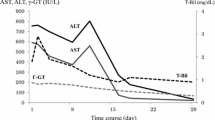Abstract
Changes in the serum hepatitis A virus anti-body (anti-HAV) response in patients with different clinical courses of HAV infection were examined using immune adherence hemagglutination (IAHA). Anti-HAV was detected 2–6 weeks after the onset of clinical symptoms in patients with the typical course of acute hepatitis A and 1–4 weeks after the onset in those with fulminant hepatitis A. Maximal anti-HAV titers were observed 8–20 weeks after the onset of clinical symptoms, and changes in anti-HAV were similar in the typical and the prolonged course of acute hepatitis A, but maximal antibody titers were higher in the prolonged course. Maximal anti-HAV titers in patients with subclinical HAV infection were significantly lower than titers in patients with the typical and prolonged courses of acute hepatitis A, and in those with fulminant hepatitis A. High titers of anti-HAV remained positive for at least 6 years after infection in patients with clinical infection and for at least 4 years in patients with subclinical infection on follow-up. These findings suggest that the maximum anti-HAV titer correlates with the clinical severity of HAV infection; knowledge of the antibody response should be useful for analyzing the pathogenesis of HAV infection.
Similar content being viewed by others
References
Locarnini SA, Ferris AA, Lehmann NI, et al. Antibody response following hepatitis A infection. Inter Virol 1977;8:309–318.
Bradley DW, Maynard JE, Hindman SH, et al. Serodiagnosis of viral hepatitis A: Detection of acute-phase immunoglobulin M anti-hepatitis A virus by radioimmunoassay. J Clin Microbiol 1977;5:521–530.
Angarano G, Trotta E, Monno L, et al. Serum IgA anti-hepatitis A virus as detected by enzyme-linked immunosorbent assay: Diagnostic significance in patients with acute and protracted hepatitis A. Diagn Microbiol Infect Dis 1985;3:521–523.
Friedman LS, Dienstag JL. The disease and its pathogenesis. In: Gerety RJ (ed) Hepatitis A. London: Academic 1984;55–79.
Woodson RD, Clinton JJ. Hepatitis prophylaxis abroad: Effectiveness of immune serum globulin in protecting Peace Corps volunteers. JAMA 1969;209:1053–1058.
Hadler SC, Erben JJ, Matthews D, et al. Effect of immunoglobulin on hepatitis A in day-care centers. JAMA 1983;249:48–53.
Fujiyama S, Iino S, Odoh K, et al. Time course of hepatitis A virus antibody titer after active and passive immunization. Hepatology 1992;15:983–988.
Wiedermann G, Ambrosch F, Kollaritsch H, et al. Safety and immunogenicity of an inactivated hapatitis A candidate vaccine in healthy adult volunteers. Vaccine 1990;8:581–584.
Innis BL, Snitbhan R, Kunasal P, et al. Protection against hepatitis A by an inactivated vaccine. JAMA 1994;271:1328–1334.
Midthun K, Ellerbeck E, Gershman K, et al. Safety and immunogenicity of a live attenuated hepatitis A virus vaccine in seronegative volunteers. J Infect Dis 1991;163:735–739.
Moritsugu Y, Dienstag JL, Doris V, et al. Purification of hepatitis A antigen from feces and detection of antigen and antibody by immune adherence hemagglutination. Infect Immun 1976;13:898–908.
Moritsugu Y, Totsuka A. Hepatitis A vaccine: Current status of development. In: Fukai K (ed) Virus vaccines in Asian countries. Tokyo: University of Tokyo Press, 1986;193–201.
Miller WJ, Provost PJ, McAleer WJ, et al. Specific immune adherence assay for human hepatitis A antibody: Application to diagnostic and epidemiologic investigation (38783) Proc Soc Exp Biol Med 1975;149:254–261.
Krugman S, Friedman H, Lattimer C. Viral hepatitis type A identification by specification by specific complement fixation and immune adherence tests. N Engl J Med 1975;292:1141–1143.
Mathiesen LR, Feinstone SM, Wong DC, et al. Enzyme-linked immunosorbent assay for detection of hepatitis A antigen in stool and antibody to hepatitis A antigen in sera: Comparison with solid-phase radioimmunoassay, immune electron microscopy, and immune adherence hemagglutination assay. J Clin Microbiol 1987;7:184–193.
Villarejos VM, Gutierrez-Diermissen V, Anderson-Visona K, et al. Development of immunity against hepatitis A virus by subclinical infection (39511). Proc Soc Exp Biol Med 1976; 153:205–208.
Almeida JD, Waterson AP. Immune complexes in hepatitis. Lancet 1969;8:983–986.
Mathiesen LR, Feinstone SM, Purcell RH et al. Detection of hepatitis A antigen by immunofluorescence. Infect Immun 1977; 18:524–530.
Mathiesen LR, Linglöf T, Møller AM, et al. Case report Fulminant hepatitis A. Scand J Infect Dis 1979;11:303–305.
Abe K, Shikata T. Fulminant type A viral hepatitis in a chimpanzee. Acta Pathol Jpn 1982;32:143–148.
Tayler M, Goldin RD, Ladva S, et al. In situ hybridization studies of hepatitis A viral RVA in patients with acute hepatitis A. J Hepatol 1994;20:380–387.
Sjogren MH, Tanno H, Fay O, et al. Hepatitis A virus in stool during clinical relapse. Ann Int Med 1987;10:221–226.
Vento S, Garofano T, Perri G, et al. Identification of hepatitis A virus as a trigger for autoimmune chronic hepatitis type I in susceptible individuals. Lancet 1991;337:1183–1187.
Weideman JT, Moritsugu Y, Miyamura K, et al. Seroepidemiology of hepatitis A virus in Japan. Jpn J Med Sci Biol 1987;40:119–130.
Author information
Authors and Affiliations
Rights and permissions
About this article
Cite this article
Sata, M., Nakano, H., Tanaka, E. et al. Analysis of serum hepatitis A virus antibody response in different courses of hepatitis A virus infection. J Gastroenterol 31, 812–817 (1996). https://doi.org/10.1007/BF02358607
Received:
Accepted:
Issue Date:
DOI: https://doi.org/10.1007/BF02358607




